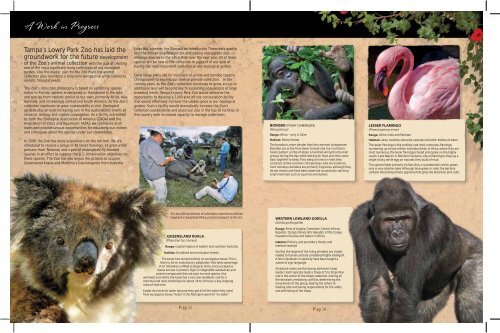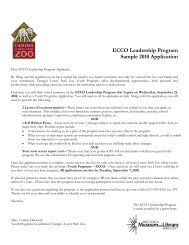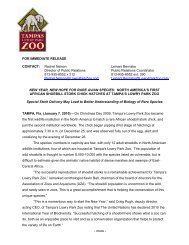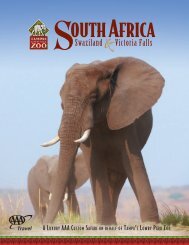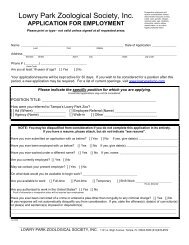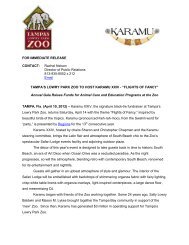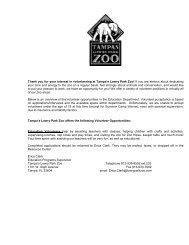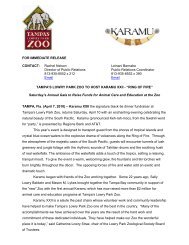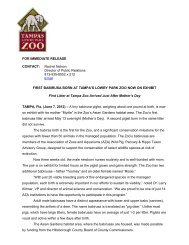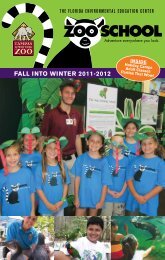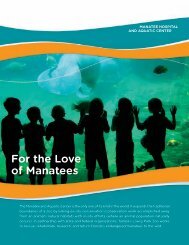Annual Report 2007 - Tampa's Lowry Park Zoo
Annual Report 2007 - Tampa's Lowry Park Zoo
Annual Report 2007 - Tampa's Lowry Park Zoo
- No tags were found...
You also want an ePaper? Increase the reach of your titles
YUMPU automatically turns print PDFs into web optimized ePapers that Google loves.
A Work in ProgressTampa’s <strong>Lowry</strong> <strong>Park</strong> <strong>Zoo</strong> has laid thegroundwork for the future developmentof the <strong>Zoo</strong>’s animal collection with the goal of creatingone of the most significant living collections of any zoologicalgarden. Like the master plan for the <strong>Zoo</strong> itself, the animalcollection plan maintains a long-term perspective while balancingrealistic financial needs.The <strong>Zoo</strong>’s collection philosophy is based on exhibiting speciesnative to Florida, species endangered or threatened in the wild,and species from habitats similar to our own, primarily Africa, Asia,Australia, and increasingly central and South America. As the <strong>Zoo</strong>’scollection continues to grow, sustainability is vital. <strong>Zoo</strong>logicalgardens play an ever-increasing role in the sustainability matrix ofresearch, biology and captive propagation. As a facility accreditedby both the <strong>Zoo</strong>logical Association of America (ZAOA) and theAssociation of <strong>Zoo</strong>’s and Aquariums (AZA), we contribute at alllevels and provide unique opportunities for educating our visitorsand colleagues about the species under our stewardship.In 2008, the <strong>Zoo</strong> has many acquisitions on the horizon. We arescheduled to receive a group of 40 lesser flamingo, 14 great whitepelicans from Tanzania, and a pair of endangered Fiji-bandediguanas in an effort to support the U.S. conservation objectives forthese species. The <strong>Zoo</strong> has also begun the process to acquireQueensland koalas and Matschie’s tree kangaroo from Australia.Later this summer, the <strong>Zoo</strong> will be introducing Thomson’s gazelleinto the African elephant exhibit and adding new gazelle andantelope species to the Safari Ride over the next year. All of thesespecies will be new to the collection in support of our goal ofhaving the most important collection in any zoological garden.Long range plans call for inclusion of gorilla and bonobo (pygmychimpanzee) to expand our diverse primate collection. In thecoming years, as the <strong>Zoo</strong>’s collection continues to grow, access toadditional land will become key to sustaining populations of largebreeding herds. Tampa’s <strong>Lowry</strong> <strong>Park</strong> <strong>Zoo</strong> would welcome theopportunity to develop a 2,000 acre off-site conservation facilitythat would effectively increase the usable space in our zoologicalgarden. Such a facility would dramatically increase the <strong>Zoo</strong>’scollection sustainability and place our <strong>Zoo</strong> in the top 10 facilities inthe country with increased capacity to manage collections.BONOBO (PYGMY CHIMPANZEE)(Pan paniscus)Range: Africa – only in Zaire.Habitat: Dense forests.The bonobo is more slender than the common chimpanzee.Bonobos are active from dawn to dusk and live in a fissionfusionpattern: a tribe of about a hundred will split into smallgroups during the day while looking for food, and then comeback together to sleep. They sleep on trees in nests theyconstruct. Unlike common chimpanzees, who are known tohunt monkeys, bonobos are primarily frugivores, although theydo eat insects and have been observed occasionally catchingsmall mammals such as squirrels and duikers.LESSER FLAMINGO(Phoenicopterus minor)Range: Africa, India and Pakistan.Habitat: Lakes, marshes, estuaries, swamps and other bodies of water.The lesser flamingo is the smallest and most numerous flamingo,numbering up to two million individual birds. In Africa, where they aremost numerous, the lesser flamingos breed principally on the highlycaustic Lake Natron in Northern Tanzania. Like all flamingos, they lay asingle chalky white egg on mounds they build of mud.This species feeds primarily on Spirulina, a cyanobacteria which growsonly in very alkaline lakes. Although blue-green in color, the bacteriacontains the photosynthetic pigments that gives the birds their pink color.Dr. Larry Killmar, director of collections, examines an Africanelephant in Swaziland Africa, prior to transport to the U.S.WESTERN LOWLAND GORILLA(Gorilla gorilla gorilla)QUEENSLAND KOALA(Phascolarctos cinereus)Range: Coastal regions of eastern and southern Australia.Habitat: Scrubland and eucalyptus forests.The koala lives almost entirely on eucalyptus leaves. This islikely to be an evolutionary adaptation that takes advantageof an otherwise unfilled ecological niche, since eucalyptusleaves are low in protein, high in indigestible substances, andcontain compounds that are toxic to most species. Likewombats and sloths, the koala has a very low metabolic rate for amammal and rests motionless for about 18 to 20 hours a day, sleepingmost of that time.Koalas do not drink water because they get all of the water they needfrom eucalyptus leaves.“Koala” is the Aborigine word for “no water.”Range: Parts of Angola, Cameroon, Central AfricanRepublic, Congo, Democratic Republic of the Congo,Equatorial Guinea and Gabon in Africa.Habitat: Primary, and secondary forests andlowland swampsGorillas, the largest of the living primates, are closelyrelated to humans and are considered highly intelligent.A few individuals in captivity have been taught asubset of sign language.Silverback males are the strong, dominant troopleaders. Each typically leads a troop of 5 to 30 gorillasand is the center of the troop’s attention, making allthe decisions, mediating conflicts, determining themovements of the group, leading the others tofeeding sites and taking responsibility for the safetyand well-being of the troop.Page 13Page 14


